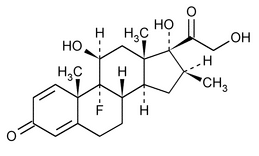Betamethasone
(bay'' ta meth' a sone).
Pregna-1,4-diene-3,20-dione, 9-fluoro-11,17,21-trihydroxy-16-methyl-, (11
9-Fluoro-11
» Betamethasone contains not less than 97.0 percent and not more than 103.0 percent of C22H29FO5, calculated on the dried basis.
Packaging and storage—
Preserve in tight containers. Store between 2 and 30
and 30 .
.
Identification—
B: Thin-Layer Chromatographic Identification Test  201
201 —
—
Test solution—
Prepare a solution of Betamethasone in dehydrated alcohol containing 0.5 mg per mL.
Developing solvent system:
a mixture of chloroform and diethylamine (2:1).
Procedure—
Proceed as directed in the chapter, except to locate the spots by lightly spraying with dilute sulfuric acid (1 in 2) and heating on a hot plate or under a lamp until spots appear.
Specific rotation  781S
781S :
between +118
:
between +118 and +126
and +126 , calculated on the dried basis.
, calculated on the dried basis.
Test solution:
5 mg per mL, in methanol.
Loss on drying  731
731 —
Dry it at 105
—
Dry it at 105 for 3 hours: it loses not more than 1.0% of its weight.
for 3 hours: it loses not more than 1.0% of its weight.
Residue on ignition  281
281 :
not more than 0.2%, a platinum crucible being used.
:
not more than 0.2%, a platinum crucible being used.
Ordinary impurities  466
466 —
—
Test solution:
methanol.
Standard solution:
methanol.
Application volume:
10 µL.
Eluant:
a mixture of toluene, acetone, methyl ethyl ketone, and formic acid (55:20:20:5), in a nonequilibrated chamber.
Visualization:
5.
Assay—
Mobile phase—
Prepare a filtered and degassed mixture of water and acetonitrile (63:37). Make adjustments if necessary (see System Suitability under Chromatography  621
621 ).
).
Internal standard solution—
Prepare a solution of propylparaben in alcohol having a known concentration of about 0.25 mg per mL.
Standard preparation—
Dissolve an accurately weighed quantity of USP Betamethasone RS in alcohol to obtain a solution having a known concentration of about 0.2 mg per mL. Transfer 10.0 mL of this solution to a suitable vial, and add 10.0 mL of Internal standard solution, to obtain a Standard preparation having known concentrations of about 0.1 mg of betamethasone and about 0.125 mg of propylparaben per mL.
Assay preparation—
Using about 80 mg of Betamethasone, accurately weighed, prepare as directed for Standard preparation.
Chromatographic system (see Chromatography  621
621 )—
The liquid chromatograph is equipped with a 240-nm detector and a 4.6-mm × 25-cm column that contains packing L1. The flow rate is about 1.0 mL per minute. Chromatograph the Standard preparation, and record the peak responses as directed for Procedure: the relative retention times are about 1.0 for betamethasone and 1.4 for propylparaben; the resolution, R, between betamethasone and propylparaben is not less than 3.0; and the relative standard deviation for replicate injections is not more than 2.0%.
)—
The liquid chromatograph is equipped with a 240-nm detector and a 4.6-mm × 25-cm column that contains packing L1. The flow rate is about 1.0 mL per minute. Chromatograph the Standard preparation, and record the peak responses as directed for Procedure: the relative retention times are about 1.0 for betamethasone and 1.4 for propylparaben; the resolution, R, between betamethasone and propylparaben is not less than 3.0; and the relative standard deviation for replicate injections is not more than 2.0%.
Procedure—
Separately inject equal volumes (about 10 µL) of the Standard preparation and the Assay preparation into the chromatograph, record the chromatograms, and measure the responses for the major peaks. Calculate the quantity, in mg, of C22H29FO5 in the portion of Betamethasone taken by the formula:
800C(RU / RS)
in which C is the concentration, in mg per mL, of USP Betamethasone RS in the Standard preparation; and RU and RS are the peak height ratios of the betamethasone peak and the internal standard peak obtained from the Assay preparation and the Standard preparation, respectively.
Auxiliary Information—
Please check for your question in the FAQs before contacting USP.
| Topic/Question | Contact | Expert Committee |
|---|---|---|
| Monograph | Domenick Vicchio, Ph.D.
Senior Scientific Liaison 1-301-998-6828 |
(SM42010) Monographs - Small Molecules 4 |
| Reference Standards | RS Technical Services 1-301-816-8129 rstech@usp.org |
USP35–NF30 Page 2335
Pharmacopeial Forum: Volume No. 29(5) Page 1427

